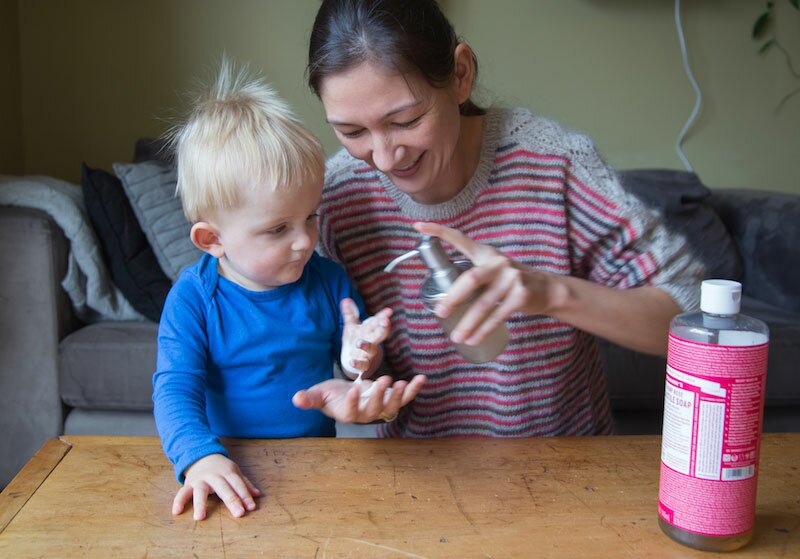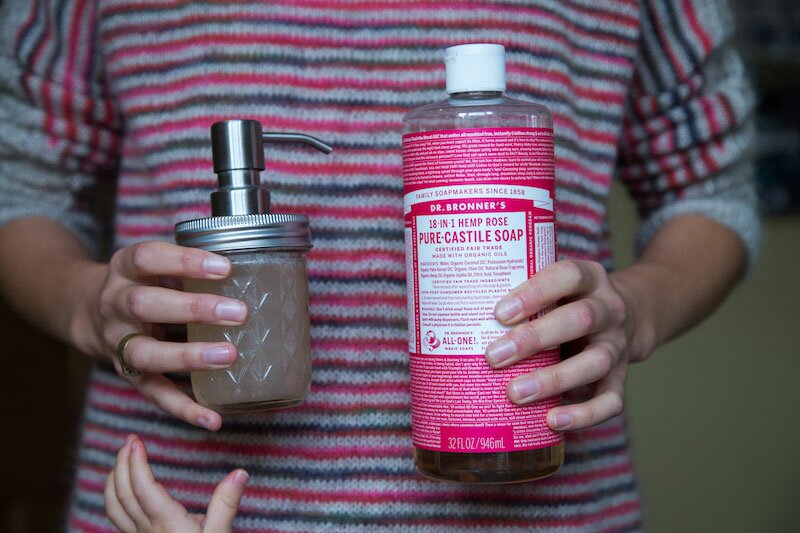Originally, I had planned for this post to be about my very cute glass preserving jar soap dispensers, and about our lovely (organic) foaming hand soap that smells beautiful and is very gentle on our hands. But then I sat down to write and I realised I actually want to share my ideas on soap and washing with it, in general. I can foresee this might not get a very enthusiastic reaction because soap and its association with hygiene is a way of thinking and behaving that is ingrained into our habits from the youngest age. There is an incredible amount of pressure to engage in the rituals of cleaning oneself according to a socially accepted norm, and certainly I feel like a bit of a deviant for admitting that I’m skeptical about the benefits of being ultra-clean. I am currently in the process of trying to convince my husband to get rid of the soap in our shower. He’s not very enthusiastic about this one because, being normal, he can’t get past the idea that he will stink if he doesn’t wash himself with (beautiful-smelling) soap. I know my ideas are not normal, but I’d like to think they are logical and practical. So, for what it’s worth, here are my thoughts on soap and cleaning with it.

Since taking an interest in fermented foods, I have noticed two recurring pieces of advice popping up in fermenting instructions:
1. Keep your preparation area and all utensils extremely CLEAN;
2. DO NOT use soap; and if you have to, make sure you rinse all soap residue away thoroughly, as fermented foods HATE soap (particularly antibacterial soap, of course)! Best to wash everything, including hands, with vinegar instead.
In order to follow these two instructions, I had to embrace the possibility that one can have a clean environment without soap. And I became curious about the possibility that vinegar could be used as a cleaner (an idea that was new to me at the time!). A little research led me to discover that a) vinegar is antimicrobial, and b) a bit of elbow grease (ie. scrubbing) with water will do an awful lot of cleaning that vinegar can then finish off for you.
I also realised I’d always thought of soap as being an effective way of killing/removing bad bacteria from my hands, without considering that it isn’t sophisticated enough to distinguish between good and bad bacteria on our skin. This, of course, was never an issue when I was oblivious to the fact that our skin (like our guts) is teeming with bacteria that are constantly working to protect us from illness and infection. A little reading around reveals that people are starting to make connections between the “anti-bacterialising” of our skin and the “anti-bacterialising” of our guts. (I’ve included links to a few interesting articles at the bottom of this post.) While there is no doubt that the widespread use of soap and hand washing have a huge impact on the spread of infectious diseases, it never occurred to me while growing up that my body has its own mechanism for self-cleaning and self-preservation. That is, until I started teaching.
For people who are new to teaching, there is a commonly acknowledged expectation that you will be sick A LOT in your first year or two of teaching. I don’t recall being sick that much in my first years, and I found that over the ten years I taught at a secondary school I would get a cold virus on average twice a year. Sometimes a nasty cold virus, but other times, just a runny nose and sore throat kind of virus. This may not sound significant in itself, but when you consider that I was exposed to up to 31 teenagers per class, and up to 6 classes per day, and during winter many of these teenagers were snotty-nosed with hacking coughs, who probably had fairly questionable hygiene practices in the school toilets (ick) which serviced up to 1600 teenagers per day, and then you consider that I practised the kind of teaching that involved me getting near to my students and conversing with them one-on-one, sometimes handling the same drawing equipment (which occasionally fell on the floor – cleaned properly once or twice a year), the fact that I got sick only a couple of times a year is pretty impressive! Moreover, although I was frequently grossed out by the imagined number of germs I was exposing myself to, I only really got to wash my hands properly when I went to the toilet between classes and/or at lunchtime.
Compared to my work environment, my own home that I returned to every afternoon was a haven of cleanliness! Even with two little children and one little dog! Teaching made me really relax my ideas about sanitising my own kitchen and bathroom by comparison. Now, the idea that I might rely on soap to keep myself from getting sick doesn’t really make sense to me anymore. I now prefer to concentrate my energy on improving my overall state of health and wellbeing through my diet and lifestyle, rather than on trying to eliminate germs from my environment.
Having said all that, there are, however, still times when you’ve just got to wash your hands with soap! Of course, you may have already read about how we brush our teeth with olive oil soap. For hand-washing, we wanted to use the most natural, ethical soap we could find with the least number of ingredients. The most affordable option was just plain old bar soap, but I really hate cleaning sinks and showers, and the scum (particularly on the glass shower door) was too much for me. So I hunted high and low for a liquid soap that was organic, sustainably produced, free of nasty ingredients, and affordable. This was tough and it took a while, but I finally found the perfect soap for us: Dr Bronner’s liquid Castile soap. It is hideously expensive at first glance (I cry a little bit inside every time I buy a bottle!), but because we dilute it at a ratio of 30% liquid soap to 70% cooled boiled water (and a couple of squirts of sweet almond oil!), one bottle lasts us for months and months. Combined with a foaming pump dispenser, our soft, fluffy, rose-scented soap lather lasts and lasts, making it an economical investment in the long run. Our quilted glass Ball jars mean we can keep four dispensers full of soap for months with only one plastic bottle required for packaging; something I’m quite proud of actually!

If you’re interested in reading some interesting articles about soap and washing with it, I’d recommend these:
http://blogs.scientificamerican.com/observations/skin-bacteria-are-your-friends/
http://www.theatlantic.com/health/archive/2012/06/soap-how-much-cleaner-does-it-actually-make-your-hands/258839/
http://www.citylab.com/navigator/2015/03/pretty-much-all-of-your-weird-germ-avoidance-behaviors-are-pointless/386015/
This article suggests that future cosmetics might involve the application of bacteria to our skin! Wow.
http://www.nytimes.com/2014/05/25/magazine/my-no-soap-no-shampoo-bacteria-rich-hygiene-experiment.html

Hi Esther. Where did you get your lovely foam dispenser please?
Hi Kelly! The soap pump dispensers were a bit of an experimental investment. I had the pumps shipped over from an Etsy seller in the US, my father-in-law cut out the stainless steel lids for me, and the stainless steel bands came from this website: https://masonjarlifestyle.com/product/stainless-steel-rust-proof-bands-rings-regular-mouth-mason-jars/
I would have loved to sell them in my shop but the pumps started to stick after about a year or so 🙁 So I’m figuring out another way to do it with more reliable (no-fail) pump heads. That website above sells some foaming pump dispenser lids if you want them? Otherwise, stay tuned… 😉 haha